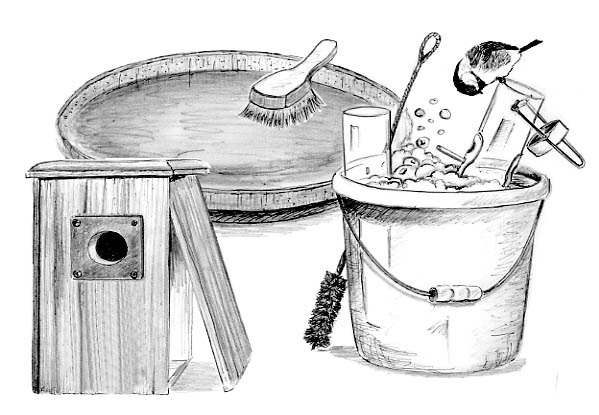
Dear Bird Folks,
Now that the winter seems to be behind us, we are doing a bit of spring cleaning around our house, both inside and out. At the very top of my list are the birds. I need to switch my feeders from winter mode to summer mode. Do you have any suggestions as to what I should do to get my feeders ready for the upcoming warmer weather?
-Madison, Franklin, MA
This is easy Madison,
It is very easy to change your feeders from “winter mode to summer mode.” All you need to do is go out in the yard and gather up all your feeders. Now lift each feeder by the top and reach underneath it. On the bottom of every feeder, that has been made since 1989, there is a toggle switch. Simply flip the toggle switch in the opposite direction and you’ll automatically move your feeder into summer mode. If your feeder was made before 1989 and doesn’t have that toggle switch, then you’ll need to get yourself a Magic Marker or a Sharpie and draw a switch on the feeder. That should work just as well.
Okay, maybe there isn’t a mode switch on bird feeders, but I like your idea of spring cleaning. Spring is a good time to give your feeders, bird houses and baths a little more attention than you are able to do during the nasty weather. Let’s start with the feeders. Once again gather up all your feeders, only instead of looking for a fictitious toggle switch, empty them out completely. Using a mild soap solution and a stiff brush, give them a thorough cleaning. Make sure you get out all of the old seed and scuzz that has built-up in your feeders over the winter. Then set them out in the sun to dry to completely before you refill them. Don’t worry that your birds will die of starvation during those few hours that your feeders are out of service. The birds may swear at you a little, but they won’t starve.
While your feeders are drying in the sun it, would be a good time to get yourself some sun. Stay outside, get out your rake, and rake up all of the crap that has gathered under your feeders. It’s not healthy for ground feeding birds to be scratching in moldy seed, rotting shells, or in the droppings left by every bird that has visited your feeder throughout the entire winter.
Next it’s time to clean out those bird houses. I am always amazed at the reaction that I get when I ask how often they clean out their boxes. They have the look of a confused beagle as it tilts its head from side to side. “Clean them out?” they ask in a sheepish voice. Yes, clean them out. With the exception of my teenage daughter, most living things would prefer clean living conditions. If possible, take your boxes down, open them up, wash them out, do whatever minor repairs are necessary and let them air dry. Unlike the feeders, we need to be careful when taking down or opening our nest boxes. Even in early spring there could be birds nesting in them. Look into the box first. If you notice fresh nesting material or clean sheets, you are too late. Somebody has already moved in. Close up the box but make sure you clean out that box as soon as those birds have finished nesting.
Once the danger of frost has passed it is safe to put your unheated bird baths back outside. Or if your bird bath is heated, it’s time to take out the heater and save on your electric bill. When you put your bird bath heater away for the season, you may want to write down where you put it, because we both know that six months from now you’ll be ripping up the garage or basement looking for it again.
Speaking of looking for stuff, the end of April is when the hummingbirds return to much of the north. While you are putting your bird bath heater away it would be a good time to start looking for your hummingbird feeder. If you can’t locate your old hummingbird feeder, the best way to find it is to buy a new one. Once you buy a new feeder, the old one will magically reappear. It happens every time, guaranteed.
With the exception of hummingbirds and orioles (they return in early May), there isn’t really a winter or summer feeding mode. Whatever works in the winter will work in the summer. The most important thing you can do, Madison, is to clean up all the scuzz that has built up in, on, and around your feeders. Also, if you did draw a toggle switch on the bottom of your feeder, wash that off too. People will be asking questions.